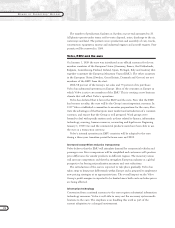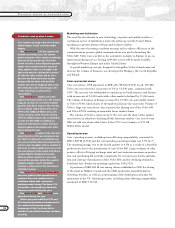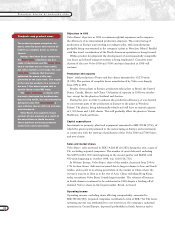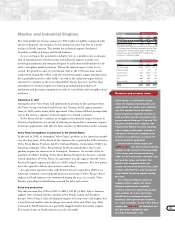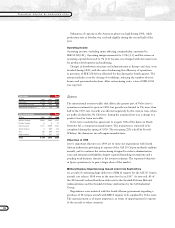Volvo 1998 Annual Report Download - page 34
Download and view the complete annual report
Please find page 34 of the 1998 Volvo annual report below. You can navigate through the pages in the report by either clicking on the pages listed below, or by using the keyword search tool below to find specific information within the annual report.
32
FINANCIAL REVIEW BY BUSINESS AREA
Objectives in 1999
Volvo Buses’ objective in 1999 is continuous global expansion and to improve
the efficiency of its international production structure. The restructuring of
production in Europe is proceeding according to plan, with manufacturing
gradually being concentrated in the company’s plant in Wroclaw, Poland. Parallel
with this trend, coordination of the North American operations is being focused.
Within product development the development of environmentally compatible
city buses and related transport systems is being emphasised. Customer intro-
duction of the new Volvo 5000 and 7000 city buses launched in 1998 will
continue.
Production and capacity
Buses’ total production of buses and bus chassis amounted to 10,230 units
(8,930). The portion of complete buses manufactured by Volvo rose sharply,
from 23% to 43%.
Besides eleven plants in Europe, production takes place in Brazil, the United
States, Canada, Mexico and China. Utilization of capacity in 1998 was satisfac-
tory, except for the plants in Scotland and Austria.
During the year, in order to enhance the production efficiency, it was decided
to concentrate parts of the production in Europe to the plant in Wroclaw,
Poland. The plant is being substantially rebuilt and will have an annual capacity
of 1,100 buses and 1,400 chassis. This will gradually affect the plants in Vienna,
Heilbronn, Vanda and Irvine.
Capital expenditures
Investments in property, plant and equipment amounted to SEK 320 M (276), of
which the greater part pertained to the restructuring in Europe and investments
in connection with the start-up of production of the Volvo 5000 and 7000 buses
and new chassis.
Sales and market shares
Volvo Buses’ sales increased to SEK 14,286 M (10,582) during the year, a gain of
4%, excluding acquired companies. The number of units delivered, including
Nova BUS with 1,160 units beginning in the second quarter and MASA with
450 units beginning in October 1998, was 10,200 (8,730).
In Western Europe, Volvo Buses’ share of the market decreased from 20% to
17%. In Asia, Buses’ deliveries increased due to larger volumes to Iran and Saudi
Arabia, and in part to its strong penetration of the market in China where the
recession was not as deep as in the rest of Asia. China, including Hong Kong,
today constitutes Volvo Buses’ fourth-largest market. The volumes of business
in South America continued to be substantial in 1998 despite a leveling off of
demand. Volvo’s share on the largest market, Brazil, increased.
Operating income
Operating income, excluding items affecting comparability, amounted to
SEK 385 M (550). Acquired companies contributed a total of SEK 7 M. The lower
operating income was attributable to cost increases in the company’s industrial
operations in Central Europe, depressed profitabilty in South America and to
The product program comprises city
buses, intercity buses and coaches all
models as complete buses as well as
chassis.
During 1998 Volvo Buses introduced
the Volvo 5000, a low-floor city bus
made of aluminum, and the Volvo 7000,
also a low-floor bus for urban traffic,
but with a stainless steel body. The new
Volvo B7L, a chassis that has been
optimized for urban traffic, was
presented at the same time. The engine
in the new bus products is a version of
the new 7-liter diesel engine that is
used in Volvo’s new FM7 truck.
The Super Olympian, a chassis with
low entry developed for doubledecker
buses in city traffic, was also introduced
during the year. The Volvo B6BLE, a
new midi-bus chassis with low entrance,
was introduced.
Volvo Buses has acquired a large
number of new products as a result of
the acquisitions in North America.
These products are being marketed
under their own brand names.
Products and product news


